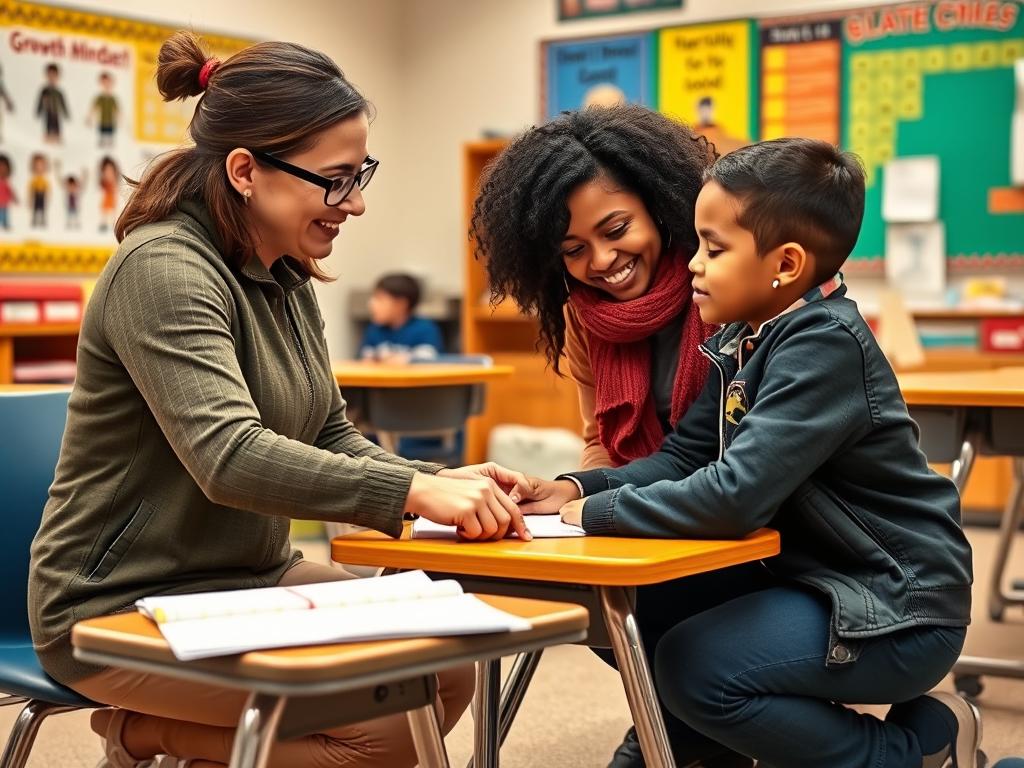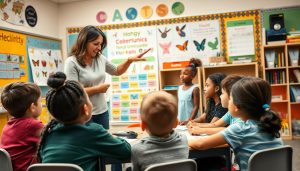Understanding Growth Mindset: The Foundation for Enhanced Teacher Skills
Psychologist Carol Dweck pioneered the concept of growth mindset, which is the belief that abilities can be developed through dedication and hard work. This contrasts with a fixed mindset, where people believe their basic qualities, like intelligence or talent, are fixed traits. Understanding this distinction is essential for developing effective teacher skills that can positively impact student outcomes.
When we embrace a growth mindset as educators, we recognize that our teaching abilities aren’t static—they can evolve and improve over time. This perspective allows us to approach challenges in the classroom as opportunities for professional growth rather than insurmountable obstacles. The same principle applies to how we view our students’ potential.
Research from Stanford University has demonstrated that students with a growth mindset show greater motivation in school, better grades, and higher test scores. By incorporating a growth mindset into our teaching practices, we can help students develop resilience, embrace challenges, and persist in the face of setbacks.
“The hand you are dealt is just the starting point for development.” —Carol Dweck
As teachers, our mindset doesn’t just affect us—it influences how we interact with students, design lessons, provide feedback, and ultimately shape the learning environment. Developing teacher skills that reflect a growth mindset means recognizing that both we and our students have untapped potential that can be developed through effective strategies and persistent effort.
Why Incorporating a Growth Mindset Transforms Teacher Skills and Student Outcomes
Before diving into implementation strategies, let’s explore why incorporating a growth mindset is worth your investment of time and energy. The benefits extend far beyond academic achievement, influencing both your professional development as an educator and your students’ approach to learning.
Benefits for Teachers:
- Enhanced teacher skills in responding to classroom challenges
- Greater resilience when facing instructional difficulties
- Improved ability to provide effective feedback
- More creative approaches to differentiated instruction
- Stronger relationships with students built on trust and high expectations
- Reduced burnout through a more positive perspective on challenges
Benefits for Students:
- Increased motivation and engagement in learning
- Willingness to tackle more challenging work
- Better response to feedback and criticism
- Higher academic achievement and test scores
- Improved collaboration with peers
- Development of lifelong learning skills
A 2021 study found that classrooms where teachers actively promoted a growth mindset showed significant improvements in student engagement and achievement. When teachers developed their skills in fostering growth mindset principles, students demonstrated greater persistence on difficult tasks and were more likely to seek help when needed.
Effective feedback is a crucial teacher skill when incorporating a growth mindset
Incorporating a growth mindset into your teaching practice isn’t just about what you say to students—it’s about creating a classroom culture that values effort, embraces challenges, and views mistakes as opportunities for learning. When you develop these teacher skills, you’re not only improving your effectiveness as an educator but also modeling the very mindset you hope to instill in your students.
Incorporating a Growth Mindset Through Classroom Language and Environment
The language we use and the environment we create in our classrooms powerfully shape students’ mindsets. Here are practical strategies for incorporating a growth mindset through your everyday interactions and classroom setup:
Mindful Language Choices
| Fixed Mindset Language | Growth Mindset Alternative | Impact on Students |
| “You’re so smart!” | “I’m impressed with how hard you worked on this!” | Focuses on process rather than innate ability |
| “This is too hard for you.” | “This may take some time and effort to figure out.” | Communicates belief in student’s ability to grow |
| “Great job! You’re a natural.” | “Great job! Your practice is really paying off.” | Attributes success to effort rather than talent |
| “Not everyone is good at math.” | “Math takes practice and different strategies.” | Removes artificial limitations on potential |
| “You made a mistake.” | “Mistakes help your brain grow. What can we learn?” | Reframes mistakes as valuable learning opportunities |
Creating a Growth-Oriented Classroom Environment
Your physical classroom space can reinforce growth mindset principles. Consider these teacher skills for designing your environment:
- Display student work that shows progress over time, not just final products
- Create a “Beautiful Oops” wall where students share how they turned mistakes into learning opportunities
- Post growth mindset quotes and affirmations around the room
- Include books with characters who demonstrate perseverance and growth
- Establish a classroom “yet” board where students can post goals they haven’t achieved “yet”
One particularly effective teacher skill is modeling your own growth mindset. Share stories of when you struggled with learning something new and how you persevered. This vulnerability helps students see that everyone—even teachers—faces challenges and can grow through effort and persistence.
Ready to transform your classroom language?
Explore our comprehensive Growth Mindset in the Classroom course to develop essential teacher skills for creating a positive learning environment.
Incorporating a Growth Mindset in Lesson Planning and Assessment
Effectively incorporating a growth mindset goes beyond motivational posters and encouraging words—it must be woven into the fabric of your curriculum, lesson planning, and assessment practices. These teacher skills ensure that growth mindset principles are consistently reinforced through the learning experience.
Lesson Design Strategies
- Provide appropriate challenge: Design tasks that stretch students just beyond their comfort zone—challenging enough to require effort but not so difficult that they become discouraged.
- Include reflection opportunities: Build in time for students to reflect on their learning process, not just content mastery.
- Teach about the brain: Incorporate age-appropriate neuroscience lessons about how the brain forms new connections when we learn.
- Use collaborative learning: Structure group work to emphasize that different students bring different strengths to the table.
- Celebrate improvement: Create lessons that allow students to see their progress over time.
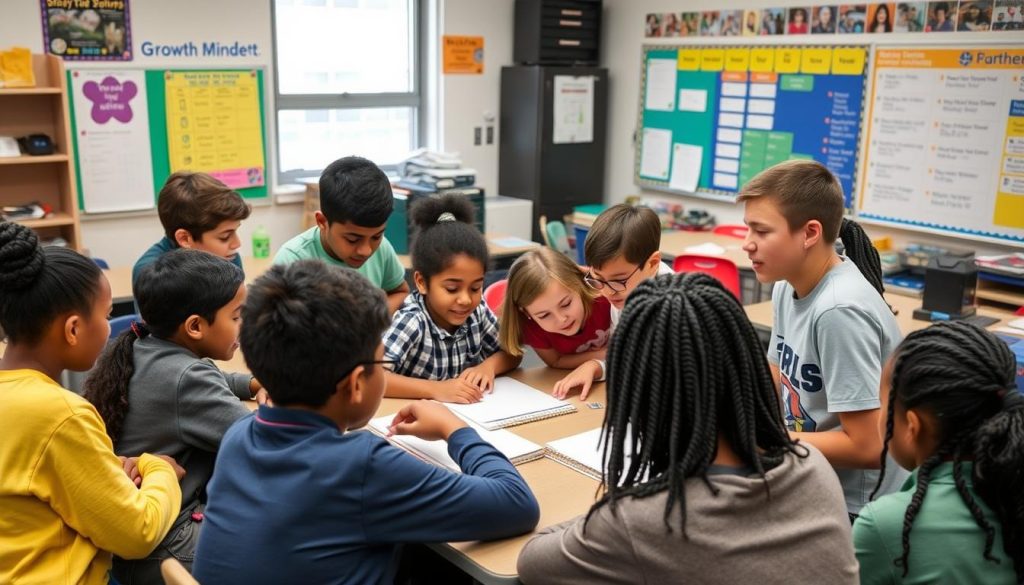
Designing appropriately challenging activities is a key teacher skill for fostering growth mindset
Assessment Approaches That Foster Growth
Traditional assessment practices often reinforce a fixed mindset by emphasizing performance over learning. Consider these alternative approaches:
Traditional Assessment
- Emphasizes final grades
- Limited or no revision opportunities
- Focuses on comparing students to each other
- Highlights what students don’t know
- One-size-fits-all testing
Growth Mindset Assessment
- Emphasizes progress and improvement
- Allows for revisions and multiple attempts
- Focuses on individual growth over time
- Highlights what students are learning
- Multiple ways to demonstrate understanding
Developing teacher skills in growth-oriented assessment practices takes time but yields significant benefits. For example, implementing “two stars and a wish” feedback (two specific strengths and one area for growth) helps students see both their accomplishments and their next steps for improvement.
Teacher Tip: Try using “not yet” grading for assignments that don’t meet standards. Instead of a failing grade, mark work as “not yet” complete and provide specific feedback for improvement. This simple shift in language communicates that success is still possible with additional effort.
Incorporating a growth mindset into your assessment practices means creating opportunities for students to act on feedback. Without the chance to revise and improve, feedback becomes merely evaluative rather than instructive. When students can apply feedback to improve their work, they experience firsthand how effort leads to growth.
Feedback Strategies for Incorporating a Growth Mindset
Effective feedback is perhaps the most crucial teacher skill when it comes to incorporating a growth mindset. The way we respond to student work and behavior can either reinforce a fixed mindset (“You’re just not good at this”) or nurture a growth mindset (“You’re developing these skills with practice”).
Process-Focused Feedback
Research shows that praising effort alone isn’t enough—we need to connect effort to outcomes and strategies. Consider these approaches:
| Instead of… | Try… | Why It Works |
| “Good job!” | “I noticed how you tried different strategies until you found one that worked.” | Highlights specific effective behaviors that led to success |
| “You’re so smart!” | “Your hard work on learning these vocabulary words has really paid off.” | Connects effort to outcomes rather than attributing success to fixed traits |
| “This is wrong.” | “Let’s look at where your thinking took a different path and figure out next steps.” | Frames errors as part of the learning process rather than failures |
| “You need to try harder.” | “Let’s talk about some specific strategies you could try next time.” | Provides actionable guidance rather than vague encouragement |
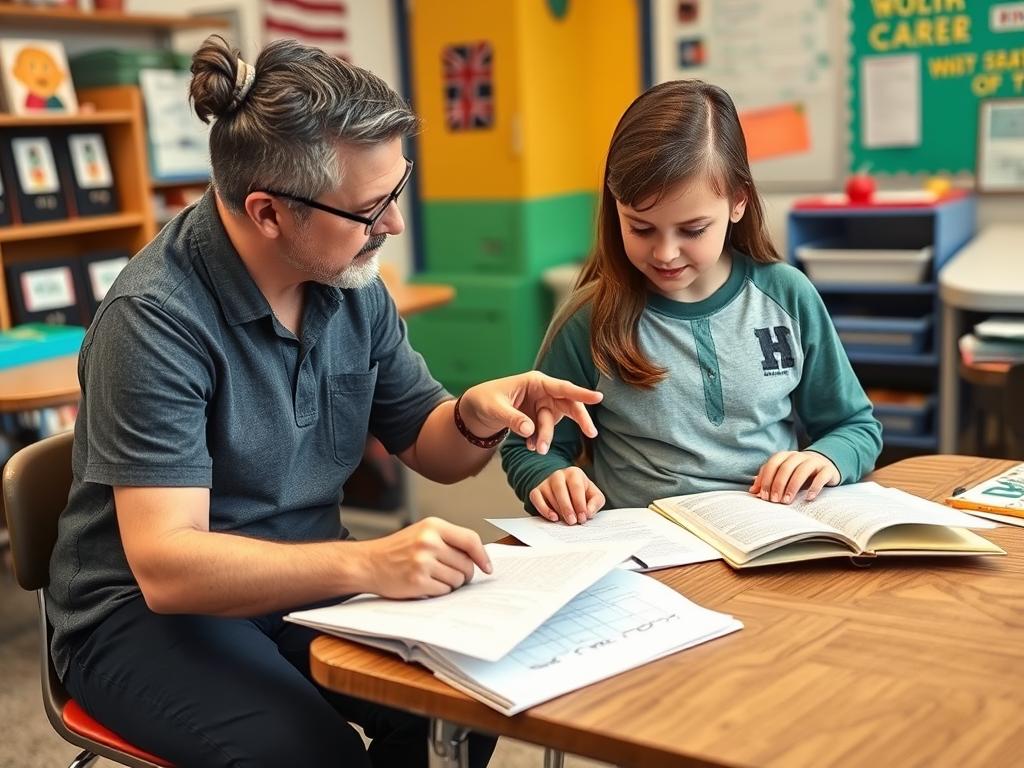
Specific, process-focused feedback is essential for incorporating a growth mindset
The Feedback Cycle
Effective feedback isn’t a one-time event but part of an ongoing cycle. Developing teacher skills in this area means creating a consistent feedback loop:
- Provide clear success criteria before students begin work so they understand the goal
- Offer specific, timely feedback focused on process and strategies
- Allow time for revision based on feedback
- Celebrate growth and improvement, not just achievement
- Encourage self-assessment to develop metacognitive skills
When incorporating a growth mindset through feedback, timing matters. Immediate feedback works best for factual knowledge, while delayed feedback can be more effective for complex conceptual understanding. Developing these nuanced teacher skills helps you provide the right type of feedback at the right time.
“Feedback is among the most powerful influences on achievement.” —John Hattie
Remember that feedback goes both ways. Creating opportunities for students to provide feedback on your teaching demonstrates that you too have a growth mindset and are continuously working to improve your teacher skills.
Enhance your feedback techniques
Looking for more strategies to provide growth-oriented feedback? Credits for Teachers offers professional development opportunities designed specifically for K12 educators.
Overcoming Challenges When Incorporating a Growth Mindset
Even with the best intentions, educators often encounter obstacles when incorporating a growth mindset into their teaching practice. Recognizing these challenges and developing teacher skills to address them is essential for sustainable implementation.
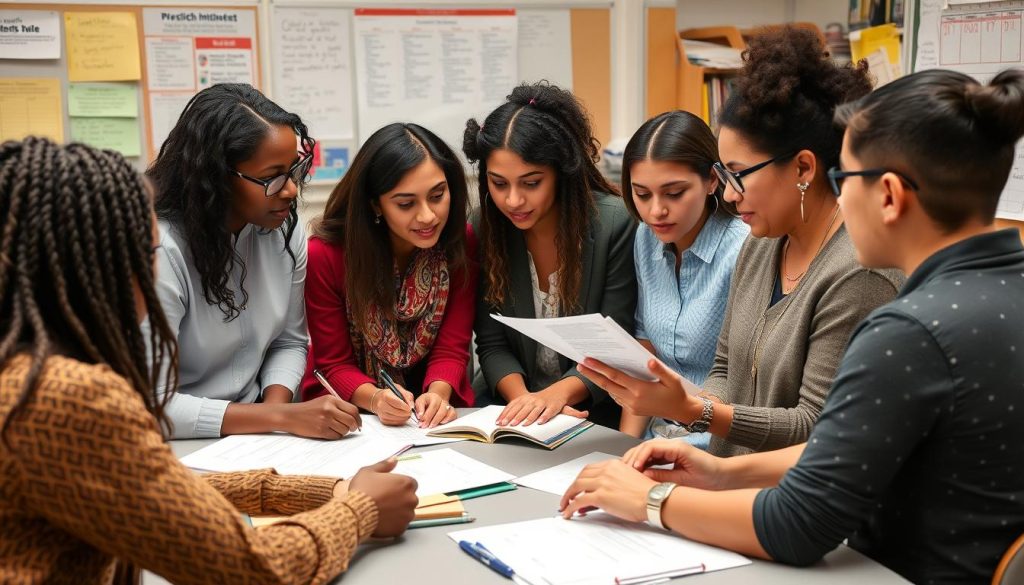
Collaborating with colleagues helps overcome challenges in implementing growth mindset practices
Common Implementation Challenges
Challenge: Mixed Messages
Students receive growth mindset messages in your classroom but fixed mindset messages elsewhere.
Solution: Partner with colleagues and parents to create consistency. Share growth mindset resources with families and collaborate with other teachers on aligned approaches.
Challenge: Praise Addiction
Students become dependent on external validation rather than developing intrinsic motivation.
Solution: Gradually shift from praise to questions that promote self-reflection: “What strategy helped you overcome that challenge?” or “How does this compare to your previous work?”
Challenge: System Constraints
School policies like standardized testing and traditional grading seem to contradict growth mindset principles.
Solution: Work within constraints by adding growth-oriented components to required assessments. For example, include reflection questions or opportunity for revisions even with standardized content.
Challenge: Teacher Burnout
Implementing new approaches requires energy and persistence that may be difficult to sustain.
Solution: Start small with one growth mindset practice at a time. Build a support network of like-minded colleagues to share resources and encouragement.
Addressing Student Resistance
Some students, particularly those who have experienced repeated academic failure or those who have been praised for being “smart” rather than for their effort, may resist growth mindset principles. Developing teacher skills to address this resistance is crucial:
- Share stories of struggle and growth from famous figures, yourself, or former students
- Provide concrete evidence of how effort leads to improvement by showing examples of progress over time
- Create safe opportunities for risk-taking where the stakes are low but the learning potential is high
- Acknowledge that growth takes time and that setbacks are a normal part of the learning process
- Celebrate small wins to build confidence and momentum
Research Insight: A 2019 study found that brief growth mindset interventions were most effective when followed by supportive classroom practices. This highlights the importance of consistent reinforcement rather than one-time discussions about mindset.
Remember that incorporating a growth mindset is itself a growth process. You’ll face challenges, learn from experience, and continuously refine your teacher skills. Approaching your own professional development with a growth mindset models the very attitude you hope to instill in your students.
Measuring Success When Incorporating a Growth Mindset
How do you know if your efforts to incorporate a growth mindset are making a difference? Developing teacher skills in assessment and reflection helps you track progress and make adjustments as needed.
Observable Indicators of Growth Mindset
Look for these signs that students are developing a growth mindset:
In Student Language:
- Using “yet” when discussing challenges
- Asking for feedback and applying it
- Discussing strategies rather than abilities
- Expressing excitement about challenges
- Encouraging peers with growth-oriented language
In Student Behavior:
- Persisting through difficulties
- Trying multiple approaches to problems
- Seeking help appropriately
- Taking academic risks
- Showing resilience after setbacks
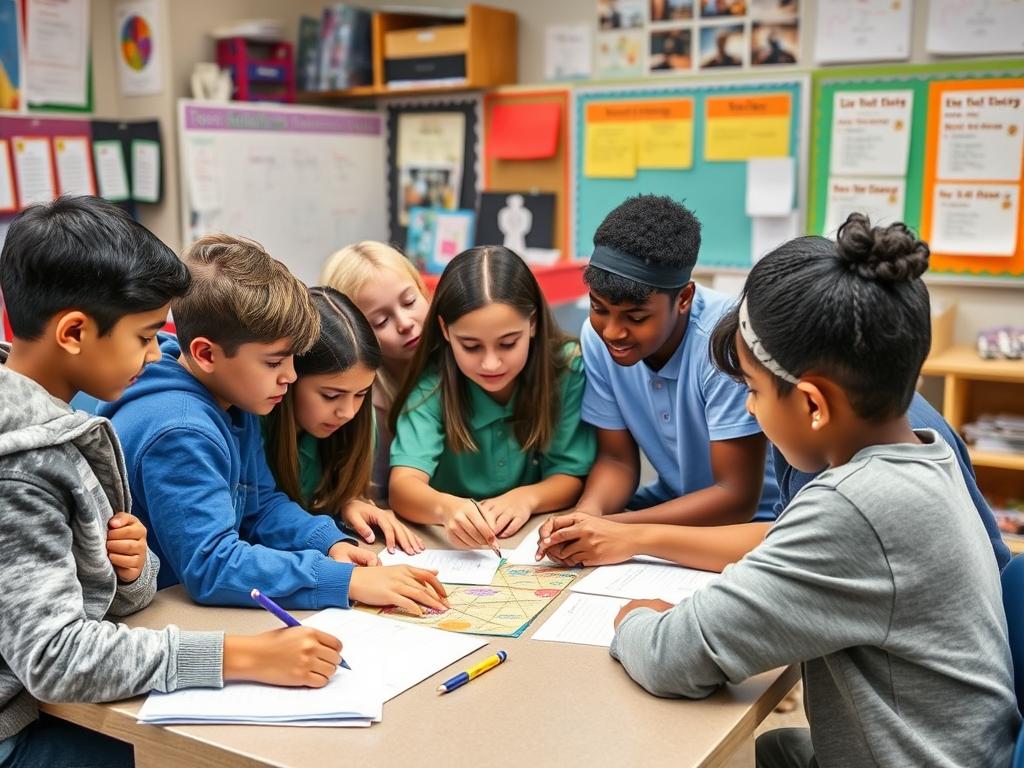
Students with a growth mindset demonstrate persistence and collaboration when facing challenges
Formal and Informal Assessment Tools
Consider these approaches to measuring growth mindset development:
- Student self-assessments: Periodic reflections where students evaluate their own mindset and approach to learning
- Mindset surveys: Brief questionnaires that gauge students’ beliefs about intelligence and learning
- Learning journals: Regular entries where students document their learning process, challenges, and strategies
- Behavioral observations: Tracking how students respond to challenges and feedback over time
- Academic persistence metrics: Measuring how long students stick with difficult tasks and whether they complete optional challenge work
Remember that incorporating a growth mindset is about long-term cultural change, not quick fixes. Some benefits may take time to appear in traditional academic measures, but improvements in student engagement and classroom climate often emerge more quickly.
“The path to a growth mindset is a journey, not a proclamation.” —Carol Dweck
Developing teacher skills in measuring mindset helps you identify what’s working and what needs adjustment. This evidence-based approach ensures that your efforts to incorporate a growth mindset are making a meaningful difference for your students.
Conclusion: Your Journey in Incorporating a Growth Mindset
Incorporating a growth mindset into your teaching practice is not a one-time event but an ongoing journey that transforms both you and your students. As you develop these essential teacher skills, you create a classroom environment where challenges are embraced, effort is valued, and every student believes in their capacity to grow.
Remember that your own mindset as an educator sets the tone. When you approach teaching challenges with curiosity rather than frustration, seek feedback on your practice, and continuously refine your strategies, you model the very mindset you hope to instill in your students.
The strategies we’ve explored—from mindful language choices to growth-oriented assessment practices—provide a roadmap for implementation. Start small by choosing one or two approaches that resonate with you, then gradually expand your repertoire as these practices become second nature.
Most importantly, be patient with yourself and your students. Shifting from a fixed to a growth mindset takes time and consistent reinforcement. Celebrate progress along the way, both in your development of teacher skills and in your students’ evolving approach to learning.
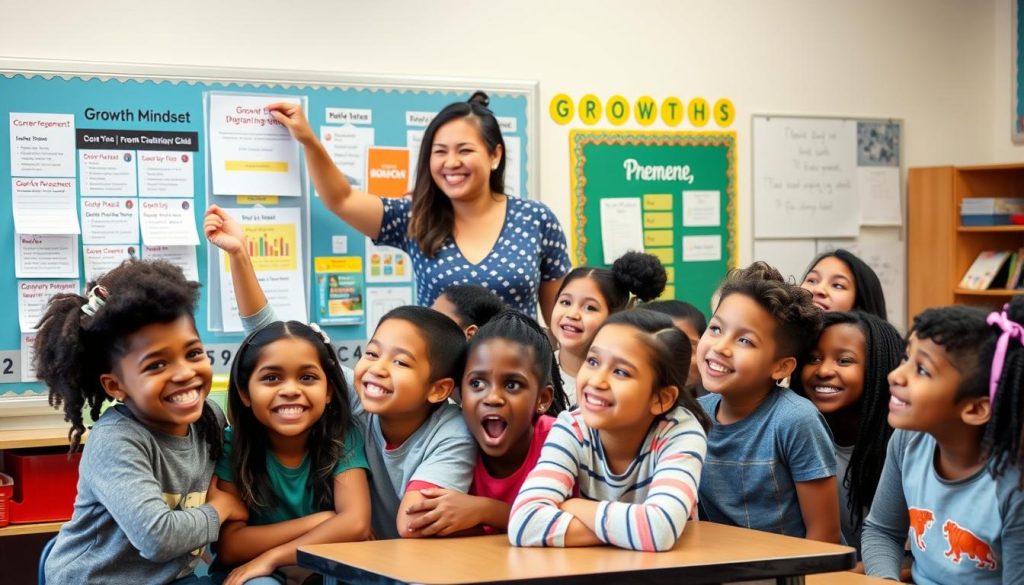
Celebrating growth and progress reinforces the value of effort and persistence
By incorporating a growth mindset into your teaching practice, you’re not just improving academic outcomes—you’re helping students develop the resilience, curiosity, and love of learning that will serve them throughout their lives. That’s the true power of a growth mindset in education.
Ready to deepen your growth mindset teaching skills?
Take the next step in your professional development journey with our comprehensive Growth Mindset in the Classroom course. Join thousands of educators who have transformed their teaching practice and student outcomes.
Enroll in Our Growth Mindset Course
Visit Credits for Teachers to explore our full range of professional development opportunities designed specifically for K12 educators.

